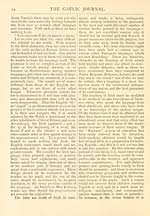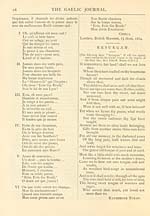Download files
Complete book:
Individual page:
Thumbnail gallery: Grid view | List view

THE GAELIC JOURNAL.
15
Erris. We speak from the experience of
similar districts to these, and we need only
refer in confirmation of the above state-
ments to the recorded opinion of Sir P. J. I
Keenan.
For those who study Irish as a non-
vernacular (we would not say a foreign)
language, the methods would suit which are
now employed in teaching other modern
languages. In adapting these to Irish, we
must first obtain good elementary works.
The three books published under the name
of the Society for the Preservation of the
Irish Language are excellent, as far as they
go, but they do not go far enough. A
fourth, fifth, sixth, and succeeding books
are required on the same plan, taking
pupils through the declensions and conju-
gations and the other portions of the gram-
mar and idioms, as also books supplemen-
tary to the first three, containing more
extended exercises on the contents of these
latter. A modification of the methods of
Ahn, Ollendorff, and Arnold combined
would, we think, be the most suitable for
these works. They should contain no un-
necessary, diffuse, or scientific disquisi-
tions ; no visionary theories or philological
hypotheses ; no doubtful etymologies or
strained explanations ; but should be clear,
concise, and, above all, correct and idiomatic
in orthography and phraseology. Such
works should be carefully written and re-
vised, and not issued till well examined and
corrected by persons possessing a practical
knowledge of the spoken language and of
its grammatical construction. Another
series of elementary treatises, with fuller
notes and explanations, should be pre-
pared for those who aim at self-instruction
in the language.
A person who does not possess a good
knowledge of a subject cannot teach it
efficiently. On the other hand, there is
many a man knowing a subject thoroughh',
and yet unable to communicate his know-
ledge easily and clearly to a pupil. Know-
ledge and the power of communicating it
are two entirely distinct things, and the
present state of Irish teaching is a very
good example of the truth of this principle.
Of the many thousands who speak Irish
fluently and correctly, how few there are
able to communicate their knowledge of
the language to others, or even capable of
rationally explaining the construction and
meaning of a simple idiomatic phrase in
their native tongue. Even most of those
who can read and write as well as speak
Irish, seem to be almost as helpless in this
respect as the mass of illiterate persons.
The remedies for this defect must be — 1st,
a careful study of the rules of Irish gram-
mar and orthography ; and 2nd, the ac-
quiring of an acquaintance with school me-
thods, particularly those used in the teach-
ing of other modern languages. Our aim
at present must therefore be two-fold— to
produce good elementary books and trained
teachers of the language. Anyone who can
speak Irish, read English, and knows some-
thing of general grammar and of another
modern language, will require very little
effort to become an efficient teacher of Irish,
if possessed of the ordinary mental qualifi-
cations necessary for every person who
aims at teaching any subject whatever.
Such a man can train himself by acting on
the lines indicated above.
LTRLANDAIS EXILE.
" Erin Gu Brath ;" i.e., " Ireland for Ever!"
" Vive a jamais ITrlande !"
Traduction du chant national Irlandais.
Par John Sullivan.
Sur une rive étrangère, reveur et melanco-
lique, un Barde proscrit chantait avec cette
ardeur, cette âme qui caractt'rise à un si
haut degré les fils do I'antique, de la mal-
heureuse Erin, de ce berceau des Bardes
OÙ naquit la sublime Poesie. Sa tunique
légère était saturée d'une rosée lourde et
glacée qui détendait ses nerfs engourdis.
II soupirait apres son Erin, sa brillante
Emeraude, sa patrie aux monts verts et
riants, qui avaient donne de I'essor à sa
verve, à son âme, à sa Ij're dcs sa plus
tendre enfance.
Un soir, à I'heure oil nait le crepuscule,
seul, expose au fort de la tempête, des
eclairs, de la foudre, entre la crainte et
15
Erris. We speak from the experience of
similar districts to these, and we need only
refer in confirmation of the above state-
ments to the recorded opinion of Sir P. J. I
Keenan.
For those who study Irish as a non-
vernacular (we would not say a foreign)
language, the methods would suit which are
now employed in teaching other modern
languages. In adapting these to Irish, we
must first obtain good elementary works.
The three books published under the name
of the Society for the Preservation of the
Irish Language are excellent, as far as they
go, but they do not go far enough. A
fourth, fifth, sixth, and succeeding books
are required on the same plan, taking
pupils through the declensions and conju-
gations and the other portions of the gram-
mar and idioms, as also books supplemen-
tary to the first three, containing more
extended exercises on the contents of these
latter. A modification of the methods of
Ahn, Ollendorff, and Arnold combined
would, we think, be the most suitable for
these works. They should contain no un-
necessary, diffuse, or scientific disquisi-
tions ; no visionary theories or philological
hypotheses ; no doubtful etymologies or
strained explanations ; but should be clear,
concise, and, above all, correct and idiomatic
in orthography and phraseology. Such
works should be carefully written and re-
vised, and not issued till well examined and
corrected by persons possessing a practical
knowledge of the spoken language and of
its grammatical construction. Another
series of elementary treatises, with fuller
notes and explanations, should be pre-
pared for those who aim at self-instruction
in the language.
A person who does not possess a good
knowledge of a subject cannot teach it
efficiently. On the other hand, there is
many a man knowing a subject thoroughh',
and yet unable to communicate his know-
ledge easily and clearly to a pupil. Know-
ledge and the power of communicating it
are two entirely distinct things, and the
present state of Irish teaching is a very
good example of the truth of this principle.
Of the many thousands who speak Irish
fluently and correctly, how few there are
able to communicate their knowledge of
the language to others, or even capable of
rationally explaining the construction and
meaning of a simple idiomatic phrase in
their native tongue. Even most of those
who can read and write as well as speak
Irish, seem to be almost as helpless in this
respect as the mass of illiterate persons.
The remedies for this defect must be — 1st,
a careful study of the rules of Irish gram-
mar and orthography ; and 2nd, the ac-
quiring of an acquaintance with school me-
thods, particularly those used in the teach-
ing of other modern languages. Our aim
at present must therefore be two-fold— to
produce good elementary books and trained
teachers of the language. Anyone who can
speak Irish, read English, and knows some-
thing of general grammar and of another
modern language, will require very little
effort to become an efficient teacher of Irish,
if possessed of the ordinary mental qualifi-
cations necessary for every person who
aims at teaching any subject whatever.
Such a man can train himself by acting on
the lines indicated above.
LTRLANDAIS EXILE.
" Erin Gu Brath ;" i.e., " Ireland for Ever!"
" Vive a jamais ITrlande !"
Traduction du chant national Irlandais.
Par John Sullivan.
Sur une rive étrangère, reveur et melanco-
lique, un Barde proscrit chantait avec cette
ardeur, cette âme qui caractt'rise à un si
haut degré les fils do I'antique, de la mal-
heureuse Erin, de ce berceau des Bardes
OÙ naquit la sublime Poesie. Sa tunique
légère était saturée d'une rosée lourde et
glacée qui détendait ses nerfs engourdis.
II soupirait apres son Erin, sa brillante
Emeraude, sa patrie aux monts verts et
riants, qui avaient donne de I'essor à sa
verve, à son âme, à sa Ij're dcs sa plus
tendre enfance.
Un soir, à I'heure oil nait le crepuscule,
seul, expose au fort de la tempête, des
eclairs, de la foudre, entre la crainte et
Set display mode to: Large image | Transcription
Images and transcriptions on this page, including medium image downloads, may be used under the Creative Commons Attribution 4.0 International Licence unless otherwise stated. ![]()
| Early Gaelic Book Collections > Blair Collection > Gaelic journal > Volume 1, number 1 > (27) |
|---|
| Permanent URL | https://digital.nls.uk/79313240 |
|---|
| Description | No. 1, Vol. I. November, 1882. |
|---|---|
| Shelfmark | Blair.214 |
| Additional NLS resources: | |
| Attribution and copyright: |
|
| Description | A selection of books from a collection of more than 500 titles, mostly on religious and literary topics. Also includes some material dealing with other Celtic languages and societies. Collection created towards the end of the 19th century by Lady Evelyn Stewart Murray. |
|---|
| Description | Selected items from five 'Special and Named Printed Collections'. Includes books in Gaelic and other Celtic languages, works about the Gaels, their languages, literature, culture and history. |
|---|

